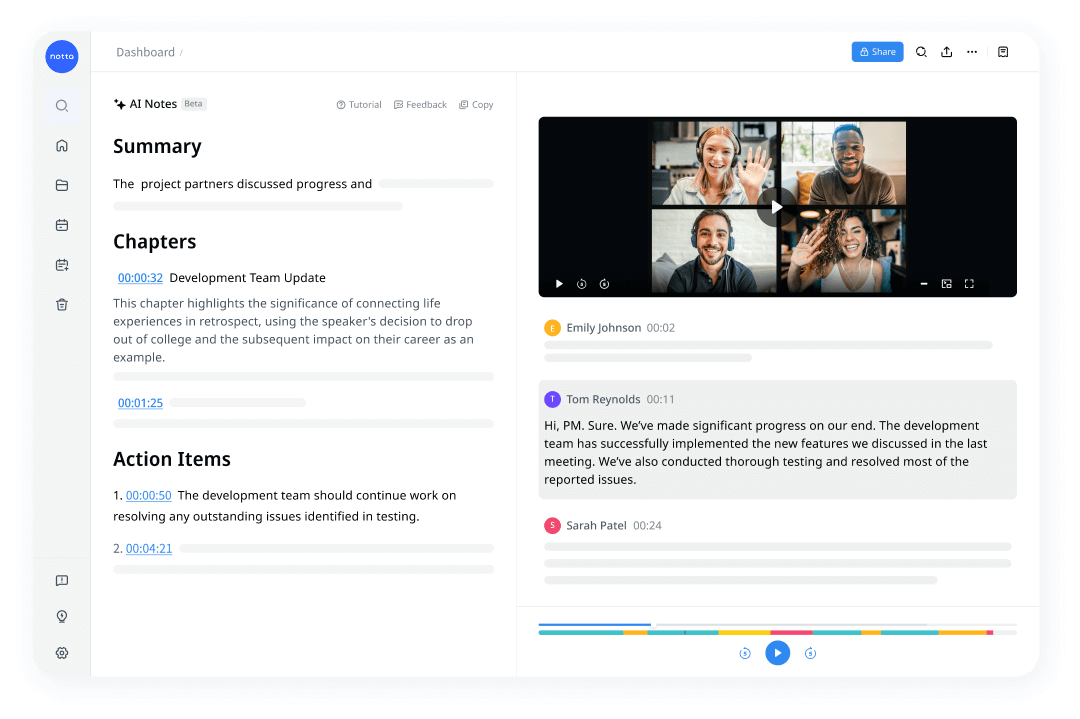
7 Must-know Tips for Effective Virtual Collaboration
Record, transcribe and summarize conversations with one click.
In the globalization era, employees and their employers have discovered the benefits of remote work — from saving costs to a better work-life balance. So much so that over the last several years, more companies have decided to operate fully remote or adopt a hybrid schedule.
However, a few challenges are associated with remote work, with one of the top challenges being hindered communication and collaboration.
Thankfully, with the help of technology and virtual collaboration tools, teams can learn how to effectively stay connected and work together even when they're not in the same physical space.
Regardless of your role or level in a company, the following must-know tips for effective virtual collaboration will help you and your team work better together.
What is virtual collaboration?
In today's modern workplace, it's essential to know what virtual collaboration is and how to do it effectively.
By definition, virtual collaboration in the workplace involves working with another person or a team to assemble knowledge and work towards a shared goal, but instead of working face-to-face, you communicate virtually.
It’s important to note that virtual collaboration can be done synchronously or asynchronously. When working synchronously, co-workers work together in real-time. Although this is often done face-to-face, synchronous collaboration can also be through video conferencing or phone calls. In contrast, asynchronous collaboration occurs when people are working with one another on the same project but not at the same time.
5 technical ways to maintain online collaboration
There are a few technical ways you can maintain online collaboration, including:
Instant messaging: This allows for real-time text communication sent over the internet. Many different platforms are available, from Slack to WhatsApp to Microsoft Teams, and each has varying features. Choosing which instant messaging platform to use will depend on your company's virtual collaboration needs and whether or not it's included in another online collaboration tool your company already uses.
Email: Electronic mail, more commonly known as email, is one way of delivering messages between people using an electronic device such as a computer or smartphone. Offered through providers such as Gmail and Outlook, email is one of the most popular forms of digital communication in the workplace to communicate project updates and other important information.
Video conferencing: Video conferencing is a digital technology that allows people to meet remotely through live video. Thanks to recent technological advancements, videoconferencing can be done over a computer, laptop, tablet, or smartphone, making it possible to meet with your team pretty much anywhere, at any time.
Project management tools: Project management tools help teams stay organized and track and manage projects and tasks more effectively. Most offer a variety of features, including a shared calendar, project planning and scheduling, and the ability to assign tasks to specific team members. The ease of having accurate data when engaging with clients about status updates is an additional advantage of using online project management tools.
File-sharing platforms: File sharing allows teams to virtually collaborate on files with varying levels of access, including the ability to read, edit, or share the file depending on what the administrator selects. Different file-sharing platforms include Microsoft OneDrive, Google Drive, and Dropbox.
The benefits of virtual collaboration
Since 2005, the number of people who work from home has increased by 140%. As this number continues to rise, so does the need for effective virtual collaboration.
When provided with the right tools and knowledge to collaborate online effectively, employees will save time, increase productivity, and communicate with their team members smoothly. Virtual collaboration can also help you and your team:
Connect from anywhere
One of the most significant benefits of virtual collaboration is the ability to connect with a person who can’t be present physically. Therefore, companies can hire talent from anywhere in the world.
So, whether they live an hour away or in another country, teams can still connect and collaborate on projects, give presentations, and conduct regular meetings. Also, forms of communication like email and instant messaging make it easier to collaborate with team members in different time zones and on busy schedules since they can respond in their own time.
Stay organized
There are many virtual collaboration tools available that can help you stay organized even without face-to-face communication.
For example, cloud-based documentation software enables teams to work on the same document or presentation in real time, which is a great way to collaborate on a project while working from different locations. Additionally, you can use a virtual meeting assistant to manage meeting notes and tasks in one central workspace.
Communicate ideas effectively
Thanks to technology, there are numerous ways teams can communicate when collaborating virtually. With so many options available today, we have the benefit of being able to select the most effective communication channel depending on the situation, level of urgency, and personal preference. For example, instant messaging can help teams communicate ideas more quickly, while email is more formal.
In many cases, a video meeting will be the most effective way to communicate with fellow team members virtually. Video meetings allow for conversations in real-time in addition to being able to see one another, share your screen, and send documents. A tool like Notta can also transcribe meeting conversations, so all team members can easily retrieve key points and refer back to if needed.

Accommodate diverse work styles
Everyone has their own work style.
Some people are detail-oriented, others are big-picture thinkers; some people enjoy working in teams, while others prefer solitude. This diversity brings different strengths to the overall team and is the key to success.
With so many different work styles, virtual collaboration is much more accommodating compared to in-person work settings. Those who thrive on their own may enjoy the ability to work from home and only reach out to their co-workers when needed, whereas social individuals can use virtual collaboration tools like video conferencing and phone calls.
Although there are clear benefits, virtual collaboration can also be challenging.
For starters, virtual collaboration is impossible without the right technology, including a computer with internet access, a working webcam, a microphone, and access to the documents within the company.
Remote employees also miss out on opportunities for bonding and connection that in-person work environments offer; loneliness can be a considerable challenge with remote work, leading to disengagement and poor performance.
And, with so many collaboration tools available, employees might experience a steep learning curve when adapting to new technology. However, employers can help mitigate these challenges by investing in tools, programs, and training for their staff.
Notta offers the most integrated AI meeting notes, summaries, and action items so nothing gets missed.
7 tips for effective virtual team collaboration
As more companies embrace remote work, companies should teach their employees how to collaborate virtually effectively. Here are a few tips.
#1 - Establish communication channels
Teams can collaborate more effectively if they're aligned on what communication channels should be used for which purposes. For example:
Instant messaging: Urgent requests, casual conversations, simple clarifications
Video conferencing: Meetings, performance reviews, presentations
Audio calls: Time-sensitive requests or to discuss details
Email: Company updates, team announcements, sending files or sensitive information, initiating dialogue, more formal conversations
Companies can help employees understand which communication channel to use by creating an internal communication process document that outlines the purpose of each channel and which one is best for different situations.
#2 - Encourage team engagement
Many people find remote work lonely, so employers must find creative ways to encourage virtual team engagement.
This could be "virtual side-by-side" working, where colleagues go on a video call and work on a shared project simultaneously. Team leads can also set up casual coffee chats through video conferencing, facilitate meeting icebreakers, or even schedule a weekly happy hour.
#3 - Turn on your camera
Video calls are the next best thing when face-to-face interaction is not possible. Although some people would rather keep their cameras off, there are benefits to turning them on during meetings.
First, humans express themselves a lot through facial expressions and body language. Whether nodding in agreement or looking confused, having your camera on allows you to understand better what others are thinking. It also helps participants focus on the meeting rather than trying to multitask.
#4 - Provide clear expectations
Setting clear expectations for remote employees helps keep the team in sync and sets everyone up for success.
Expectations might include setting specific work hours, clearly defined communication processes, scheduling regular team meetings to check in, or asking employees to send weekly project updates. Some other expectations might be:
Requiring team members to set an "away" status when they are not at their desks
Making their calendar visible to their entire team
Sharing their time zone in their profiles or email signatures
Letting your team know what you expect of them can help everyone stay on task and eliminate confusion.
#5 - Invest in virtual collaboration tools
Virtual collaboration tools help employees succeed when working on remote teams. Therefore, it only makes sense to research the various tools available and invest in the ones you feel will be most beneficial.
Of course, you should also offer adequate training to all employees, so they know how to effectively use these tools and get the most out of them.
#6 - Organize project information and team files
With the ability to send files through various communication channels, including email and instant messaging, it's easy for files to get lost, deleted, or become difficult to locate. This is why the entire team must know how to organize files properly and where to access important information.
Cloud storage options like Google Drive and Notion are great ways to create shared folders where team members can access the files they need.
#7 - Take care of data security
Whenever you share sensitive information, check the privacy settings and who has access. The original creator of the file should be able to control not only who can access it but also select view only or the ability to edit a file.
It's also essential to ensure everyone understands how to keep company data safe. This can be accomplished through cybersecurity training courses, regular reminders to update passwords, and creating a data security policy that outlines security requirements.
Notta AI meeting assistant records, transcribes, and summarizes meetings so everyone can stay engaged without missing important details.
Virtual collaboration as the new normal
As organizations worldwide continue to shift from traditional in-person workplaces to remote work, learning how to collaborate online effectively is imperative to ensure your team remains productive, engaged, and aligned with the company's mission and goals.
To benefit the most from using virtual collaboration, ensure your team has the tools they need, understands how to use them, and is open to continuously improving online communication.